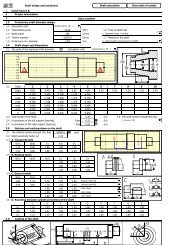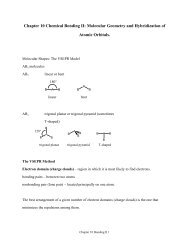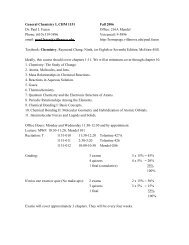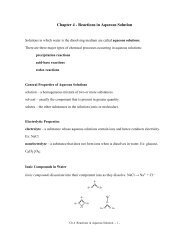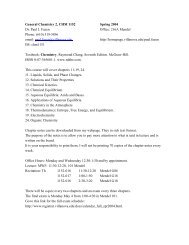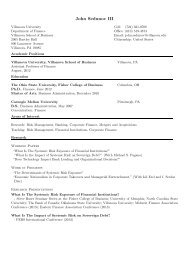A Culture of Collaborative Inquiry: Learning to Develop and Support ...
A Culture of Collaborative Inquiry: Learning to Develop and Support ...
A Culture of Collaborative Inquiry: Learning to Develop and Support ...
Create successful ePaper yourself
Turn your PDF publications into a flip-book with our unique Google optimized e-Paper software.
ased on the book we were reading <strong>and</strong> applying it <strong>to</strong> what wewere doing in our PLCs.Tom expressed similar feelings:[<strong>Inquiry</strong>] is one <strong>of</strong> the best things about the steering committee <strong>and</strong>this is exactly what we‘ve tried <strong>to</strong> export <strong>to</strong> other programs.There‘s a, I think, a strong culture <strong>of</strong> inquiry in the SC <strong>and</strong> that‘sreally been honored <strong>and</strong> it‘s something that everyone has valued<strong>and</strong> if we start moving away from it somebody notices <strong>and</strong> sayssomething, ―Hey we need <strong>to</strong> keep this part <strong>of</strong> our work intact <strong>and</strong>not let the management stuff crowd it out.‖ It‘s <strong>to</strong>o easy for us <strong>to</strong>do that, there‘s never enough time for management issues.Although there was a consensus as <strong>to</strong> the value <strong>of</strong> our collaborative<strong>and</strong> questioning approach, as the second year <strong>of</strong> implementationbegan, this had <strong>to</strong> be renegotiated along two dimensions. First, thegroup examined whether there was a new inquiry question <strong>to</strong>pursue in the second year. Although some felt that the existingquestion was still appropriate, other ideas emerged as well, <strong>and</strong>significant time during the September <strong>and</strong> November 2005 SCmeetings was devoted <strong>to</strong> refining the inquiry focus. Employing aconsensus model for decision-making <strong>and</strong> using pro<strong>to</strong>cols <strong>to</strong>ensure broad discussion <strong>and</strong> participation, ―How can we grow <strong>and</strong>support teacher leaders who can foster <strong>and</strong> sustain a culture <strong>of</strong>collaborative inquiry?‖ was selected as the new focus. As can benoted, the new inquiry question was designed <strong>to</strong> maintain ouroriginal focus (foster <strong>and</strong> sustain a culture <strong>of</strong> collaborative inquiry)but also <strong>to</strong> more directly insert the application <strong>of</strong> our inquiry in<strong>to</strong>the work <strong>of</strong> the project (supporting teacher leaders as they engagedtheir colleagues in a critical <strong>and</strong> reflective examination <strong>of</strong> teaching<strong>and</strong> learning). It remains <strong>to</strong> be seen the degree <strong>to</strong> which this was anominal or substantive change.The second aspect <strong>of</strong> renegotiation arose from the fact that 100new teachers entered the project at the onset <strong>of</strong> Year 2, <strong>and</strong> thePLCs now became ―exp<strong>and</strong>ed PLCs‖ (in addition <strong>to</strong> thecontinuation <strong>of</strong> the ―lead teacher PLCs‖ in some districts). Thisincreased the number <strong>of</strong> learning communities needing supportfrom the facilita<strong>to</strong>rs <strong>and</strong> placed severe strains on project resources.Further, a lack <strong>of</strong> awareness <strong>of</strong> project goals <strong>and</strong> structures in themajority <strong>of</strong> the ―exp<strong>and</strong>ed team‖ teachers provided increasedtensions. Unlike the lead teachers, the project did not provide theexp<strong>and</strong>ed-team teachers with a shared experience, such as thesummer academy, <strong>to</strong> explore their knowledge <strong>and</strong> beliefs abouthigh quality learning <strong>and</strong> teaching or develop a conception <strong>of</strong> whatit meant <strong>to</strong> be a member <strong>of</strong> a learning community. Additionally,two new facilita<strong>to</strong>rs joined the project part-time, <strong>and</strong> Arne <strong>to</strong>ok ontwo new districts <strong>to</strong> facilitate. These changes put pressure on theSC <strong>to</strong> deal explicitly with practical needs—in other words, thebusiness felt more pressing than the inquiry. Although Daveventured that ―Our business is inquiry,‖ it was difficult <strong>to</strong>practically realize our inquiry in service <strong>of</strong> our needs <strong>to</strong> support thelead teachers through the changes they were facing with theexp<strong>and</strong>ed PLCs. There was simply not enough time in the monthlymeetings <strong>to</strong> deal with the complexities involved in attending <strong>to</strong> all<strong>of</strong> the teachers‘ needs as well as the other business aspectsassociated with a grant project. The shift in the inquiry focus, asdescribed above, resulted from these tensions.COLLABORATIVE STRUCTURES SUPPORTING ANINQUIRY STANCEThe SC comprised people from diverse pr<strong>of</strong>essional backgroundswith a multitude <strong>of</strong> experiences <strong>and</strong> beliefs. Any such group mayencounter challenges associated with perceived status, differingreward systems or work tempos, or different goals <strong>and</strong>/or agendas14 | P a g e




